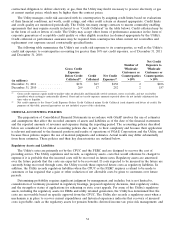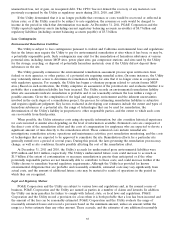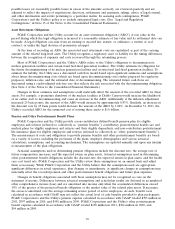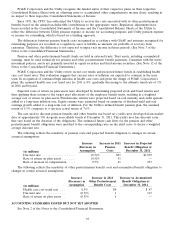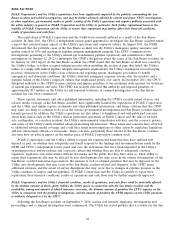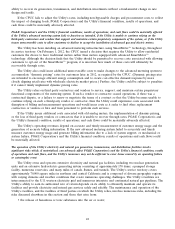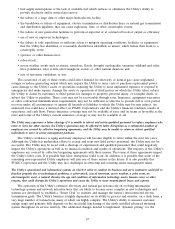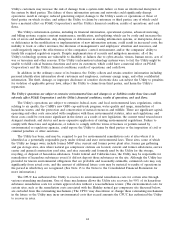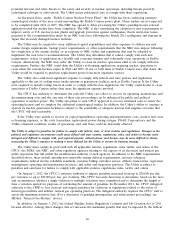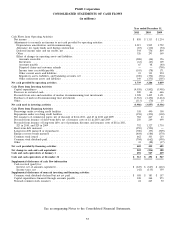PG&E 2011 Annual Report Download - page 47
Download and view the complete annual report
Please find page 47 of the 2011 PG&E annual report below. You can navigate through the pages in the report by either clicking on the pages listed below, or by using the keyword search tool below to find specific information within the annual report.•fuel supply interruptions or the lack of available fuel which reduces or eliminates the Utility’s ability to
provide electricity and/or natural gas service;
• the failure of a large dam or other major hydroelectric facility;
• the breakdown or failure of equipment, electric transmission or distribution lines, or natural gas transmission
and distribution pipelines, that can cause explosions, fires, or other catastrophic events;
• the failure of new generation facilities to perform at expected or at contracted levels of output or efficiency;
• use of new or unproven technologies;
• the failure to take expeditious or sufficient action to mitigate operating conditions, facilities, or equipment,
that the Utility has identified, or reasonably should have identified, as unsafe, which failure then leads to a
catastrophic event;
• operator or other human error;
• cyber-attack;
• severe weather events such as storms, tornadoes, floods, drought, earthquakes, tsunamis, wildland and other
fires, pandemics, solar events, electromagnetic events, or other natural disasters; and
• acts of terrorism, vandalism, or war.
The occurrence of any of these events could affect demand for electricity or natural gas; cause unplanned
outages or reduce generating output which may require the Utility to incur costs to purchase replacement power;
cause damage to the Utility’s assets or operations requiring the Utility to incur unplanned expenses to respond to
emergencies and make repairs; damage the assets or operations of third parties on which the Utility relies; subject
the Utility to claims by customers or third parties for damages to property, personal injury, or wrongful death, or
subject the Utility to penalties. These costs may not be recoverable through rates. Insurance, equipment warranties
or other contractual indemnification requirements, may not be sufficient or effective to provide full or even partial
recovery under all circumstances or against all hazards or liabilities to which the Utility may become subject. An
uninsured loss could have a material effect on PG&E Corporation’s and the Utility’s financial condition, results of
operations, and cash flows. Future insurance coverage may not be available at rates and on terms as favorable as the
rates and terms of the Utility’s current insurance coverage or may not be available at all.
The Utility may experience a labor shortage if it is unable to attract and retain qualified personnel to replace employees who
retire or leave for other reasons, the Utility’s operations may be affected by labor disruptions as a substantial number of
employees are covered by collective bargaining agreements, and the Utility may be unable to retain or attract qualified
individuals to serve in senior management positions.
The Utility’s workforce is aging and many employees will become eligible to retire within the next few years.
Although the Utility has undertaken efforts to recruit and train new field service personnel, the Utility may not be
successful. The Utility may be faced with a shortage of experienced and qualified personnel that could negatively
impact the Utility’s operations as well as its financial condition and results of operations. The majority of the Utility’s
employees are covered by collective bargaining agreements with three unions. The terms of these agreements impact
the Utility’s labor costs. It is possible that labor disruptions could occur. In addition, it is possible that some of the
remaining non-represented Utility employees will join one of these unions in the future. It is also possible that
PG&E Corporation and the Utility may face challenges in attracting and retaining senior management talent.
The Utility’s operational and information systems on which it relies to conduct its business and serve customers could fail to
function properly due to technological problems, a cyber-attack, acts of terrorism, severe weather, a solar event, an
electromagnetic event, a natural disaster, the age and condition of information technology assets, human error, or other
reasons, that could disrupt the Utility’s operations and cause the Utility to incur unanticipated losses and expense.
The operation of the Utility’s extensive electricity and natural gas systems rely on evolving information
technology systems and network infrastructures that are likely to become more complex as new technologies and
systems are developed to establish a ‘‘Smart Grid’’ to monitor and manage the nation’s interconnected electric
transmission grids. The Utility’s business is highly dependent on its ability to process and monitor, on a daily basis, a
very large number of transactions, many of which are highly complex. The Utility’s ability to measure customer
energy usage and generate bills depends on the successful functioning of the newly installed advanced metering
system throughout its service territory. The additional changes needed to implement ‘‘dynamic pricing’’ for the
43



